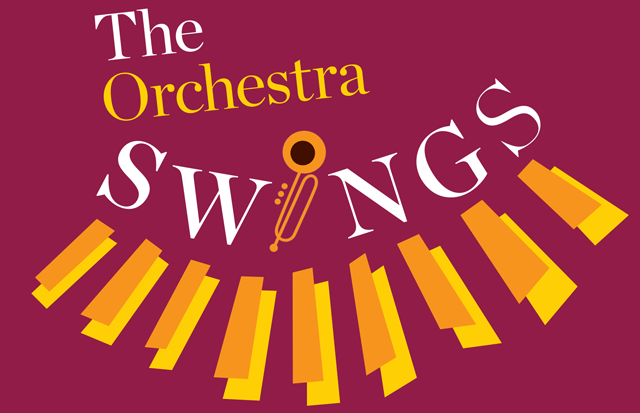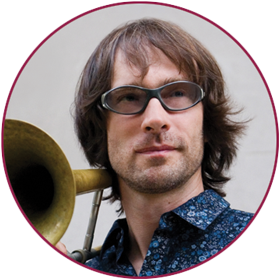The Orchestra Swings

Now in its 32nd season, Link Up is the longest-running education initiative of Carnegie Hall’s Weill Music Institute (WMI). Designed for students in grades 3–5, the program facilitates deeper connections between the concert hall and the classroom through an instrument-focused curriculum that culminates in an annual participatory concert. This month marks the inaugural concerts of The Orchestra Swings—the first new Link Up program since 2012—with the Orchestra of St. Luke’s conducted by Rossen Milanov, and co-hosted by teaching artist Thomas Cabaniss and jazz musician Chris Washburne, who also leads the Rags and Roots jazz septet. One of the highlights of the performances will be the premiere of composer Courtney Bryan’s new work, “Do Your Thing,” commissioned especially for The Orchestra Swings.
WMI recently spoke with three key collaborators—Mr. Washburne, Ms. Bryan, and music teacher April Rachmuth—about their Link Up experiences leading up to the concerts this May.

Chris Washburne
You have worked with WMI for 16 years. What is your role in the upcoming Swings concerts?
Having the opportunity to reach younger audiences and instill how music matters in their lives is so important for their future and for ours. For the upcoming concerts, I am leading and performing with my jazz band Rags and Roots. I also arranged the jazz pieces that will be performed at the concerts and have led professional development sessions to introduce the material to classroom teachers across the city. On top of that, I’ve also served as my fourth-grade daughter’s private recorder coach! I am so honored to have the opportunity to share the concept of “swing” with so many young people around the world and show how this concept we have inherited from African American culture can enrich our lives.
It’s not often that a jazz ensemble is featured with an orchestra. What do you hope the students will gain from that in these concerts?
This is certainly a unique experience for both ensembles, reflecting a long distinction and separation between jazz and classical music in which the genres are spoken about and treated in oppositional ways. As a musician who has performed with both orchestras and jazz ensembles, I have always found this separation to be strange and artificial, especially considering that for the last century, both jazz and classical musicians and composers have turned to one another for inspiration. I hope students will come away from the concert seeing both genres as interrelated and complementary, and recognize that you cannot truly understand the music of George Gershwin and Leonard Bernstein without understanding jazz, and that you cannot truly understand the music of Duke Ellington without understanding classical music. As Ellington once said, there are only two types of music—good and bad—and that is a much more useful distinction for me.
How did you go about selecting the repertoire for the program?
We chose pieces that clearly demonstrate the ways in which classical and jazz music are interrelated, and how both can swing in their own way. We also commissioned a new piece titled “Do Your Thing” by Courtney Bryan, a young composer who embodies the coming together of both genres.

Courtney Bryan
How did you select the text for “Do Your Thing”?
The text I chose is from the African American ring game “Little Sally Walker.” I remember my mother singing part of it to me when I was younger, and it continues to be performed by children today. In the game, one child pretends to be the character Sally Walker, while the other children form a circle around that child. The children rotate the circle until the child in the middle chooses the next Sally Walker. Each time a child is in the middle, they create their own dance moves, so the children express their individuality within the collective.
How did you go about featuring the jazz ensemble with the full orchestra?
In “Do Your Thing,” the focus is on musicians improvising, rather than dancing. Members of the jazz ensemble improvise as guided in the score, and there are even a few written improvisations for members of the orchestra. The jazz ensemble and orchestra are one entity—much like the children in a ring game—where there is space for individual expression, but the focus is on the collective sound. The highlight for me is the interaction between the children in the audience and the musicians onstage as they participate in call-and-response throughout the piece.
What do you hope students will experience by listening to and participating in this piece?
I hope the students realize that you can take something familiar and create something new. The elements that I used in the piece already existed—the lyrics and rhythm of “Little Sally Walker,” the form of the 12-bar blues, and eight-bar forms common in jazz standards—and I combined them with new elements to create a different piece. Throughout the year, the students have been working on creating their own blues as part of the Link Up Swings program. I hope that when they see the instruments of the orchestra and the jazz ensemble performing together onstage at Carnegie Hall, they realize that they can write a piece of their own one day based on what they learned through the Link Up curriculum.

April Rachmuth
How does the Link Up program benefi t your students at PS 100Q?
This is the fourth year that we are participating in the program. The curriculum is well organized, with multiple pathways to accommodate students with varying abilities. It includes online resources that supplement the printed materials, and the professional development provided highlights the program and gives the teachers the tools they need to engage their students. The students’ workbook, teachers’ online materials, and each song’s corresponding activities enhance our understanding of the genre and the repertoire we’re studying.
How has the program changed throughout the years?
As the program has evolved, the Carnegie Hall team has gained a greater understanding of teachers’ and students’ needs. The student workbooks and teacher guides now include carefully honed material that enhances our understanding of the repertoire. For example, more composition activities have been added, which facilitate more student directed learning. In addition, there are more online resources available to supplement the user guides, including rubrics and assessment tools that help the students and teachers ensure that active dialogue is part of the repertoire-learning experience.
What have you enjoyed most about the new Swings curriculum?
It has been a joy to introduce my students to a genre of music they would not normally encounter in their everyday lives. They have met important musicians of that era (Ella Fitzgerald, Duke Ellington, Louis Armstrong) and made connections to their current music interests. As young musicians, they have embraced the challenge of performing syncopated rhythms with swung eighth notes, and have used movement to understand and experience these new rhythms. While exploring the song “Duke’s Place,” they learned about and attempted improvisation. We have also made curriculum connections to math when learning about the 12-bar blues and exploring patterns and form in “I’ve Got Rhythm.” “It Don’t Mean a Thing (If It Ain’t Got That Swing)” gave them (and their teacher) an opportunity to step outside of their comfort zone and move with the music, as originally intended by the composers. For a brief moment, we were transported to the swing era.
Lead support for Link Up is provided by the Fund II Foundation.
Additional funding for Link Up is provided by The Jean and Louise Dreyfus Foundation, The Ambrose Monell Foundation, and The Barker Welfare Foundation.
Link Up in New York City schools is made possible, in part, by an endowment gift from The Irene Diamond Fund.
